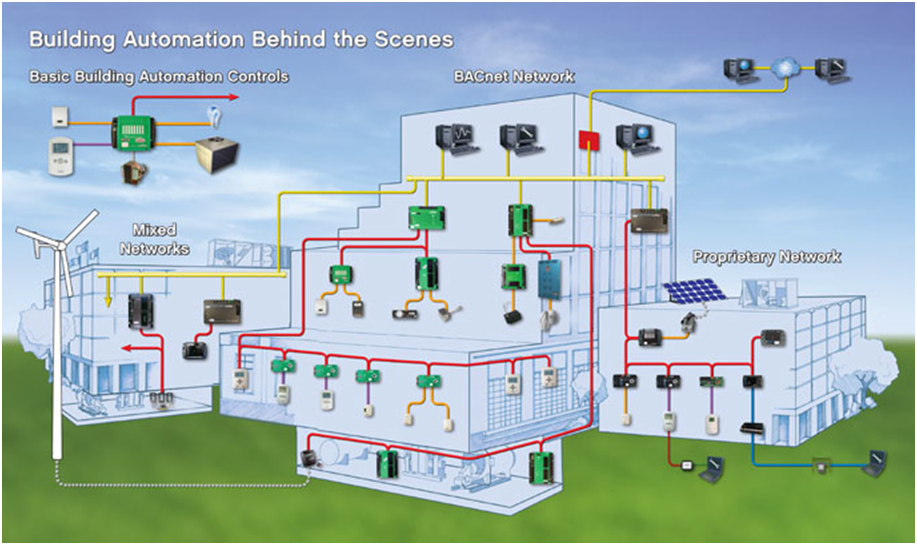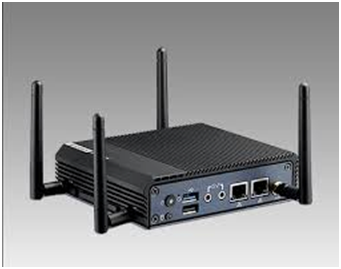A Gateway to smarter building automation
How a complete IoT gateway system combines hardware, software and security to Increase energy efficiency and reduce costs for smart buildings. By Ken Chang, Product Manager, Advantech.
Rising power consumption, increasing emissions, mounting energy costs; these and other factors are driving the need for a sustainable, eco-friendly future. However, although research continues on clean and renewable energy sources, such as wind and solar, the capital cost of producing a unit of energy has doubled since 2000. It’s time for another approach.
This is the promise of the Internet of Things (IoT). By harnessing the power of connectivity, data, and analytics, the IoT can effect real change on the commercial and industrial sectors through building automation systems (BAS) that monitor and adjust power consumption according to usage, reducing financial and ecological waste without impacting lifestyles or economic efficiency.
To realise the full potential of IoT-enabled building automation, gateways capable of unifying the various systems within a facility are required. But to date, industry has produced few systems that incorporate the connectivity, security, and manageability needed to bring the vision of a green future in line with the building automation architectures of today.
Evolving automation for smarter buildings
Since the formation of the ENERGY STAR program more than 20 years ago, a wave of ‘smart’ technologies has surfaced with the goal of improving energy efficiency and reducing cost, including utility meters, thermostats, lights, and even electrical outlets. These devices are now widely used in many commercial and industrial settings, and while they may yield savings of one kind or another, energy used by commercial and industrial facilities in the United States still currently accounts for nearly half the country’s greenhouse gas emissions and costs more than $200 billion annually.
This inefficiency is the result of growing complexity associated with smart building automation, or building automation systems (BAS). Building automation systems are centralised machine-to-machine (M2M) networks used to monitor and control the environment within a facility, and are often responsible for managing systems that range from heating, ventilation, and air conditioning (HVAC), to lighting, power, plumbing and water. Oddly enough, however, the addition of energy-saving devices and applications, along with their diverse connectivity requirements, have made optimising BAS a challenge (Figure 1).

Figure 1: Despite efforts to standardise communications around the BACnet protocol in the 1990s, emerging applications have complicated network topologies and system management for building automation systems (BAS).
For example, if we liken a building automation to a car engine, in the event of overheating temperature sensors transmit information via CAN bus to an engine control unit (ECU). The ECU then uses the CAN protocol to activate a fan, preventing engine failure. Much in the same way, Wi-Fi occupancy sensors should be able to leverage BAS infrastructure to report a status change. Pre-defined rules stored in the cloud could then be implemented to modify the operation of ZigBee-enabled lighting systems or a BACnet-based HVAC unit, thereby optimising energy usage. However, if communication is inhibited to or from the ECU or BAS (for instance by an unsupported protocol) increased efficiency cannot be achieved.
In addition to intricate connectivity provisions, other requirements for modern BAS include: off-the-shelf price points and easy integration to minimise capital expenditure (CAPEX) and accommodate multiple deployments; rugged-but-unobtrusive packaging for deployment in harsh industrial environments as well as consumer-centric retail settings; remote manageability that enables unified system management over diverse application sets or multi-site control; high reliability that ensures continuity for safety-critical systems and sensitive data, and; end-to-end hardware and software security to protect the BAS network from application to backend network infrastructure.
A new Gateway to Building Automation
To overcome the obstacles of BAS, facilities managers and property owners are turning towards Internet of Things (IoT) designs that incorporate a BAS gateway to provide connectivity between device-side networks and backend network infrastructure (Figure 2). The advantage of an IoT gateway for smart building applications is that they are equipped to support multiple device-side communications protocols that are then converted to IP to access the cloud. Unfortunately, to-date IoT gateway platforms have not been available as complete system solutions that incorporate the enterprise-grade features BAS demand. As a result, smart building architects have been forced to turn to custom gateway solutions, incurring high integration costs and extended time to market in the process.

Figure 2: An Internet of Things (IoT) gateway acts as an intermediary between device-side networks and the cloud, as well as a chokepoint for unnecessary data transfer and security risks.
Identifying the need for an off-the-shelf platform with the flexibility to meet the needs of smart building applications, Advantech developed the UTX-3115 Fanless Box PC, a complete system solution for BAS gateways based on the dual-core 1.46 GHz Intel Atom processor E3826 (Figure 3). on Intel Gateway Solutions for the Internet of Things that combines the Intel Atom E3826 processor (formerly codenamed “Bay Trail”) and technology from Intel Internet of Things Solutions Alliance members McAfee and Wind River, Advantech UTX-3115 is a complete solution that enables real-time monitoring and remote management to optimise BAS. From modular components to market-ready systems, Intel and the 250+ global member companies of the Alliance provide the scalable, interoperable solutions that accelerate deployment of intelligent devices and end-to-end analytics. Close collaboration with Intel and each other enables Alliance members to innovate with the latest technologies, helping facility owners and managers reduce operating expenditures (OPEX) to extract maximum value from commercial and industrial assets.

Figure 3: The UTX-3115 is a complete, off-the-shelf gateway solution that provides the flexibility required for building automation systems (BAS).
Beyond a range of native I/O suited for the diverse connectivity requirements of BAS gateways, the UTX-3115 is compactly packaged in a 139mm (L) x 117mm (W) x 36mm (H) aluminium housing and capable of operation over a -20ºC to +60ºC temperature range, rendering it small enough to be discretely positioned in retail locations as a standalone platform or using a VESA mount, but with rugged characteristics that allow it to be installed on DIN rails in industrial environments.
While the aforementioned features make the UTX-3115 well suited for a range of BAS deployments, its combination of processing performance and extensive storage capability empower the platform as more than a gateway. Based on the 22nm Silvermont microarchitecture and a superscalar out-of-order execution engine, the Intel Atom processor E3826 affords three times the peak performance of previous-generation Atom processors, which can be used in conjunction with the mSATA and 2.5” HDD/SSD storage expansion options to conduct processing for data analytics. For cost-sensitive BAS deployments, localised processing is a significant value add as it helps reduce the amount of data traffic on a BAS network, in turn minimising transmission costs.
Bundled solutions
A prerequisite for IoT gateways is designed-in flexibility to support a range of functions, which has limited the effectiveness of existing systems with monolithic architectures. Consequently, ad hoc hardware and software components are often added to networking equipment, such as routers, resulting in disjointed systems that are incapable of providing the optimised security, management, and development capabilities needed for applications like building automation.
In order to consolidate these functions in a single platform, the UTX-3115 was engineered using the new Intel Gateway Solutions for the IoT (formerly codenamed Moon Island) as a foundation, a technology suite from Intel and fellow Intel IoT Solutions Alliance members McAfee and Wind River that improves performance, enhances security, eases manageability, and facilitates application development. Available only on hardware platforms running Intel Quark SoC X1000 series or Intel Atom processor E3800 product family SKUs, the UTX-3115 realises the benefits of Intel Gateway Solutions for the IoT in a number of ways for BAS applications, beginning at the chip level.
The Intel Atom processor E3826 allows the UTX-3115 to take advantage of advanced technologies such as Intel Virtualization Technology (Intel VT), which increases the throughput and performance of networked devices and peripherals by securely partitioning essential tasks from operations that are less important. In a BAS gateway, this capability is imperative for ensuring that key functions receive priority execution, and that the resulting data is transmitted to the UTX-3115 platform in an expedient manner. Data integrity is further supplemented by technologies such as Intel Advanced Encryption Standard New Instructions (Intel AES-NI) and Secure Boot, which respectively work to accelerate data packet encryption and verify that the UTX-3115 boots in a known-good state, validating both network traffic and the gateway system itself.
McAfee Embedded Control takes a new approach to system security by implementing application whitelists as opposed to the blacklisting methodology traditionally utilised by antivirus companies; blocking all undesignated software from running on a system. In effect, this protects the UTX-3115 from malicious malware that infiltrates a BAS network by only allowing authorised code to run or pre-approved software changes to be made. Furthermore, this architecture can help prevent viruses and rootkits from propagating to clean parts of the network. These protections can also be extended to the application layer to help secure scripts, batch files, and other components.
Designed using Wind River software and tools, its Intelligent Device Platform IDP XT 2.0 provides a secure environment for developing Java-, Lua-, and OSGi-based gateway applications, and also contains a communications stack that extends UTX-3115 connectivity to the cloud while supporting wireless protocols such as Bluetooth, ZigBee, Wi-Fi, and MQTT. Equally as important, IDP XT 2.0 supports the management protocols OMA DM and TR-069, along with a web interface, so that facility managers can remotely access and control BAS systems in situations that involve multiple buildings and/or cover large geographic areas. Wind River also recently announced a partnership with cloud provider Axeda that will offer users direct access to an established backend cloud platform, making the UTX-3115 a scalable, end-to-end gateway solution with implications on each level of the IoT ecosystem.
Extending Automation
Because BAS gateways require high availability and long-term reliability, Advantech also furnished the UTX-3115 with an additional, in-house-developed management technology that extends the capabilities of IDP XT 2.0, namely SUSIAccess 3.0.
SUSIAccess 3.0 is a web- and cloud-based device monitoring framework that offers insight into real-time hardware and software diagnostics so that the UTX-3115 can be managed remotely. With cross-platform functionality, SUSIAccess runs in Linux and Windows environments, as well as iOS and Android. By supporting iOS and Android, BAS administrators are able to leverage the bring-your-own-device (BYOD) experience so common in enterprise environments, as UTX-3115 system messages and alerts can be pushed to an operator’s phone or tablet.
The greatest challenge facing smart building owners and operators is the reality that BAS lifecycles must match the lifetimes of the buildings they control. As technology evolves, this fact demands that BAS infrastructure be designed for a future that will include periodic system upgrades in order to protect investments and reduce capital expenditures (CAPEX).
Supported by the security of Intel roadmaps, platforms like the UTX-3115 provide the ground-up scalability needed to advance BAS deployments without costly re-integration. Thanks to the portability of the Intel Architecture and development flexibility of IDP XT 2.0, adopting the UTX-3115 offers possibilities for code reuse and easy platform migration that improve design consistency over the life of a BAS. Combined with extensive connectivity, manageability, and security resources, this provides a future-proof blueprint for building automation.
While energy and cost savings generated by smarter commercial and industrial buildings will be measured over the long term, with Advantech IoT gateways for BAS they can be realised today. It’s time to start building a brighter future.

Figure 4: The Wind River Intelligent Device Platform (IDP) XT 2.0 is a key feature of the UTX-3115 as it enables ubiquitous connectivity, extensive platform management, and versatile development options for smart building management systems.










